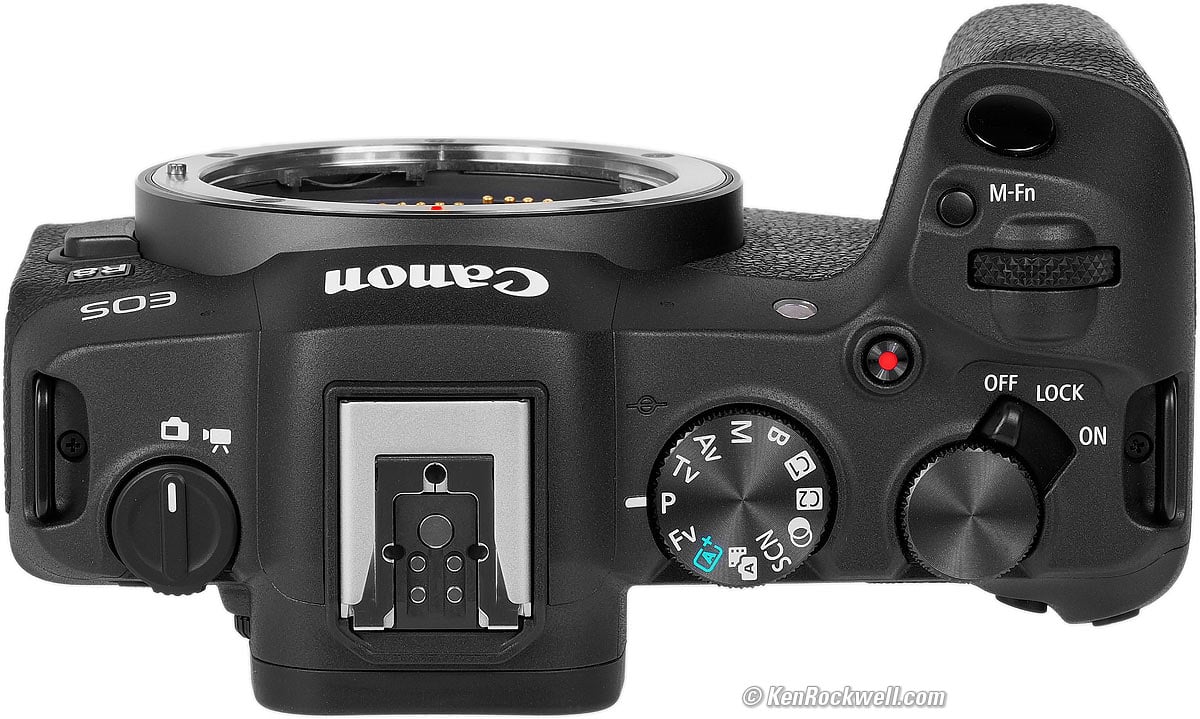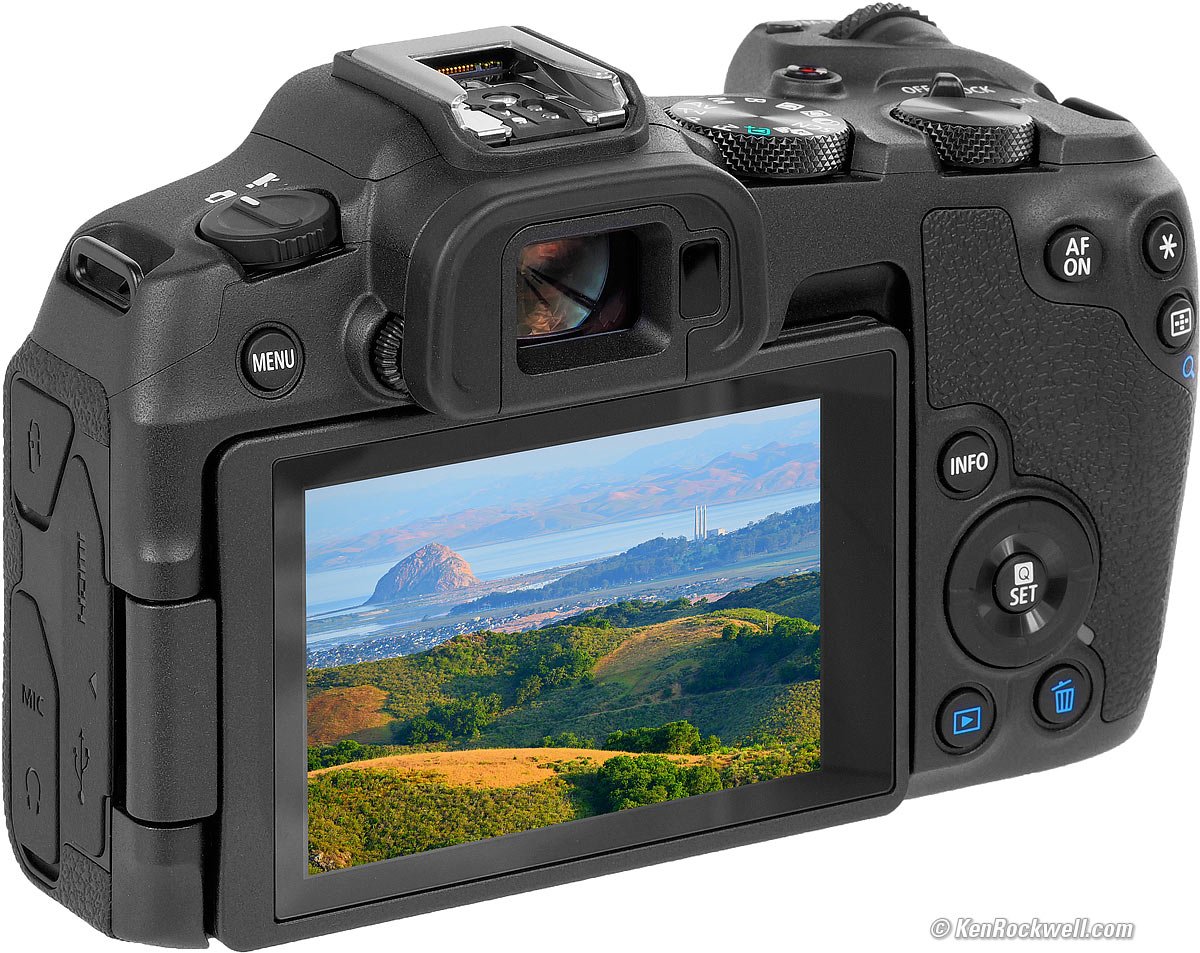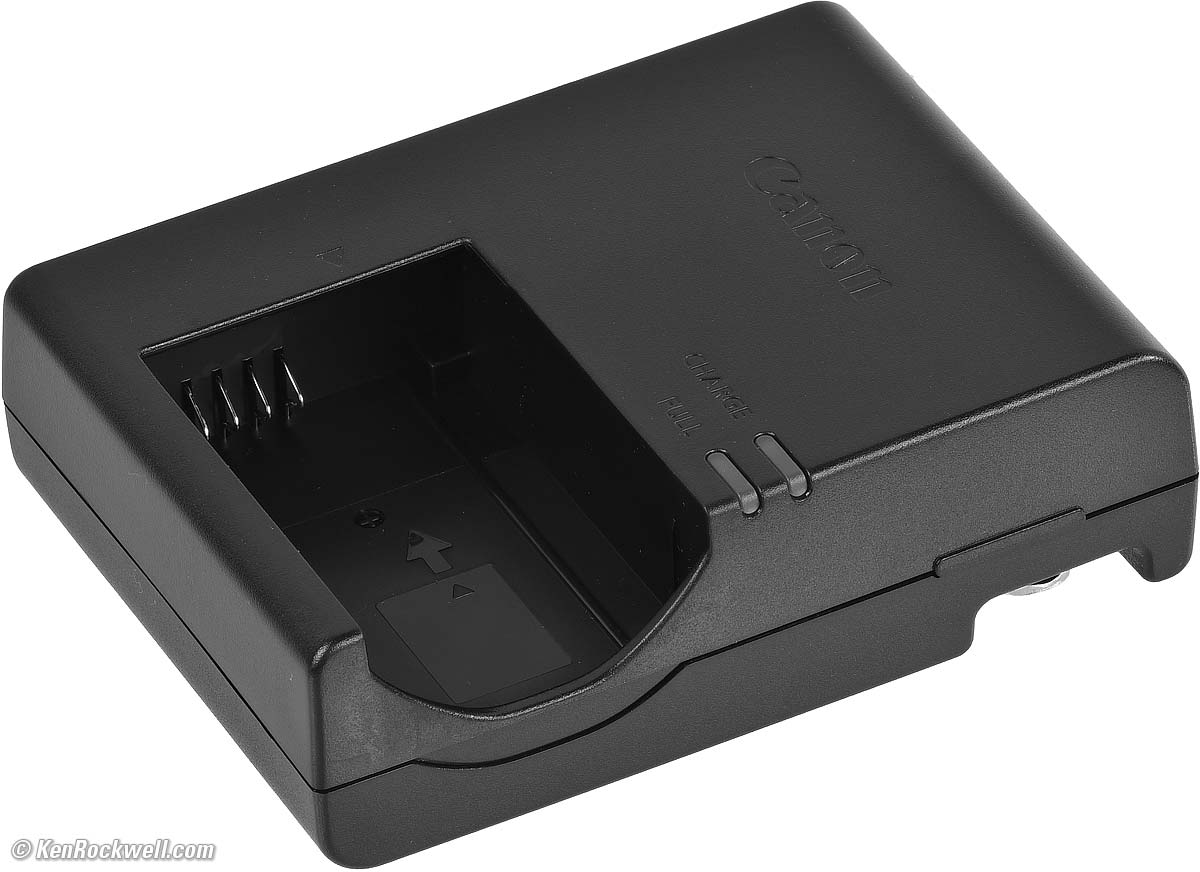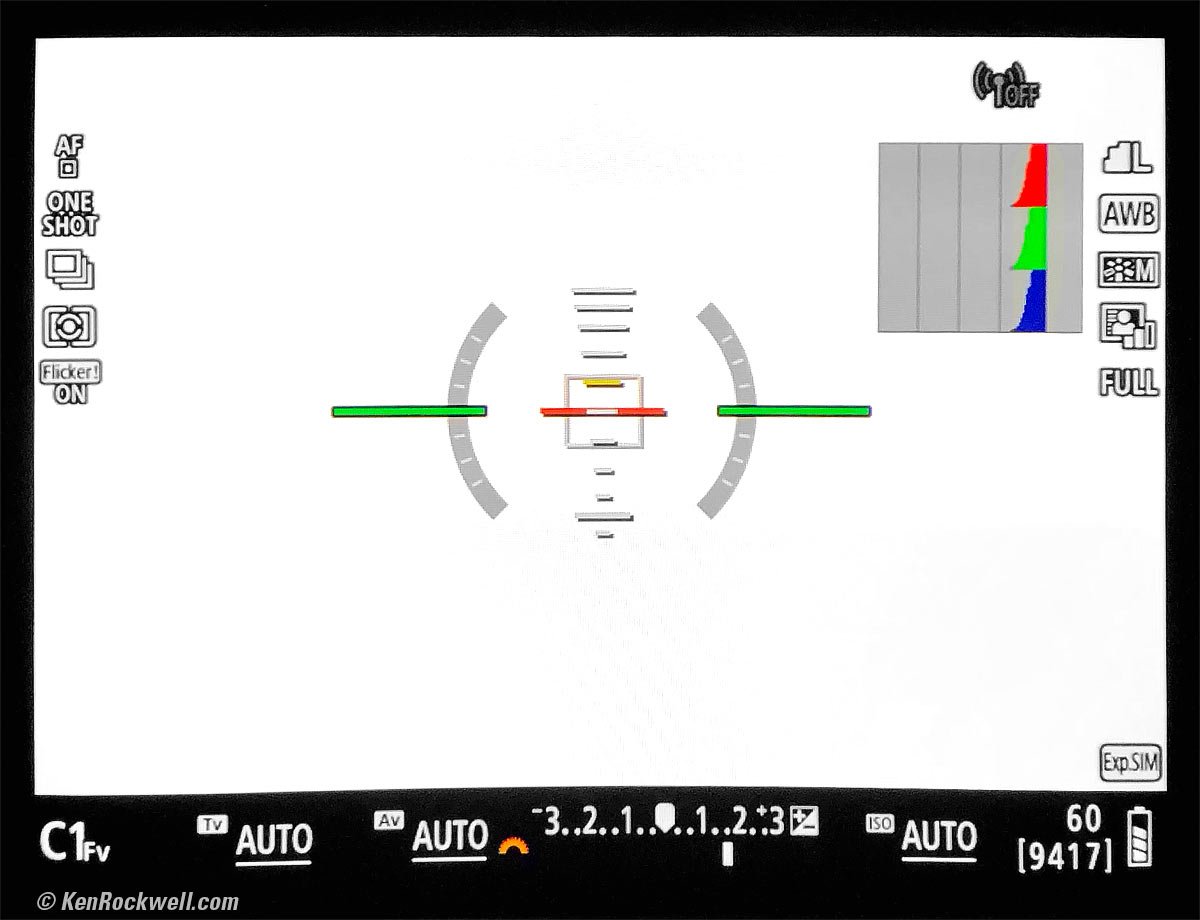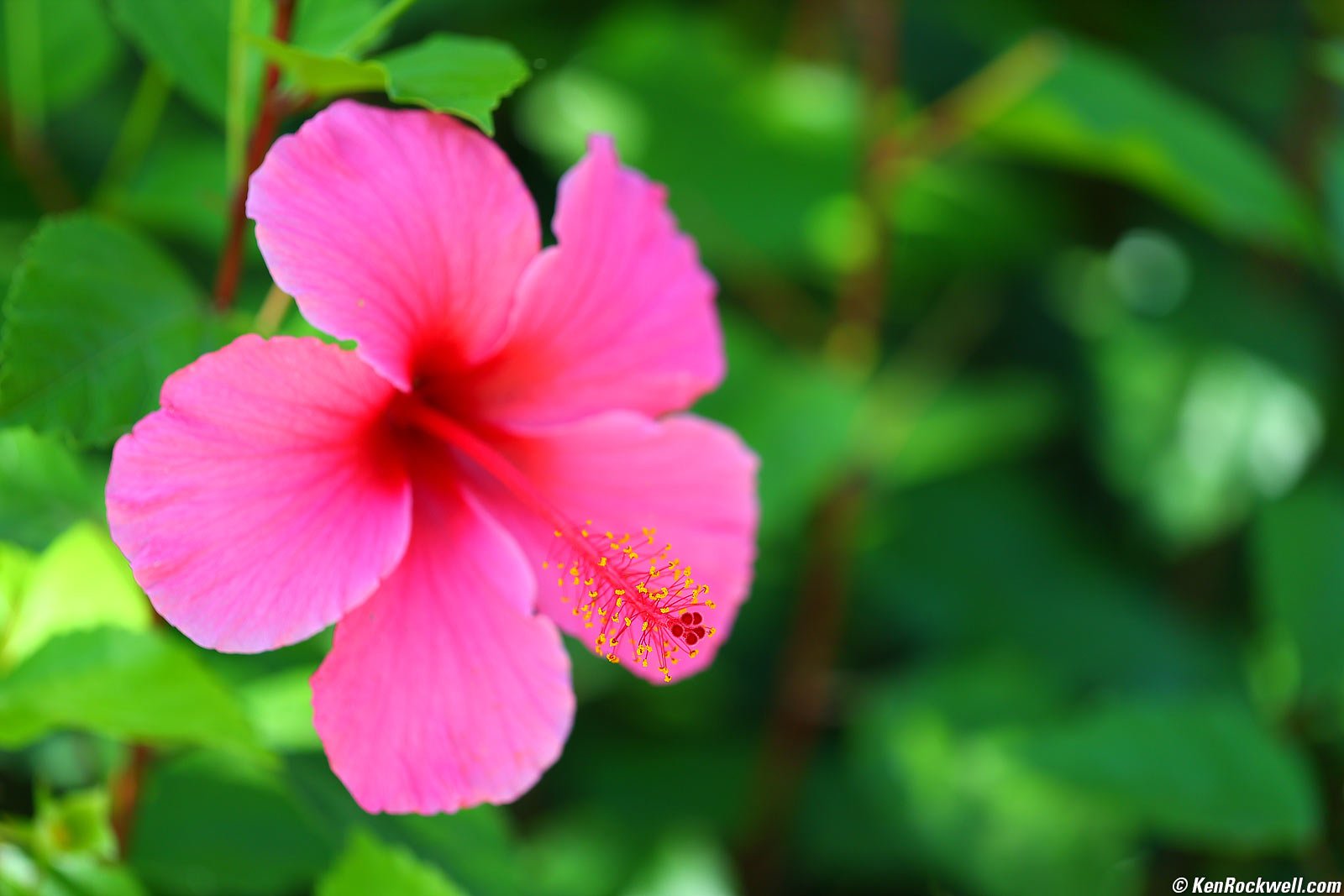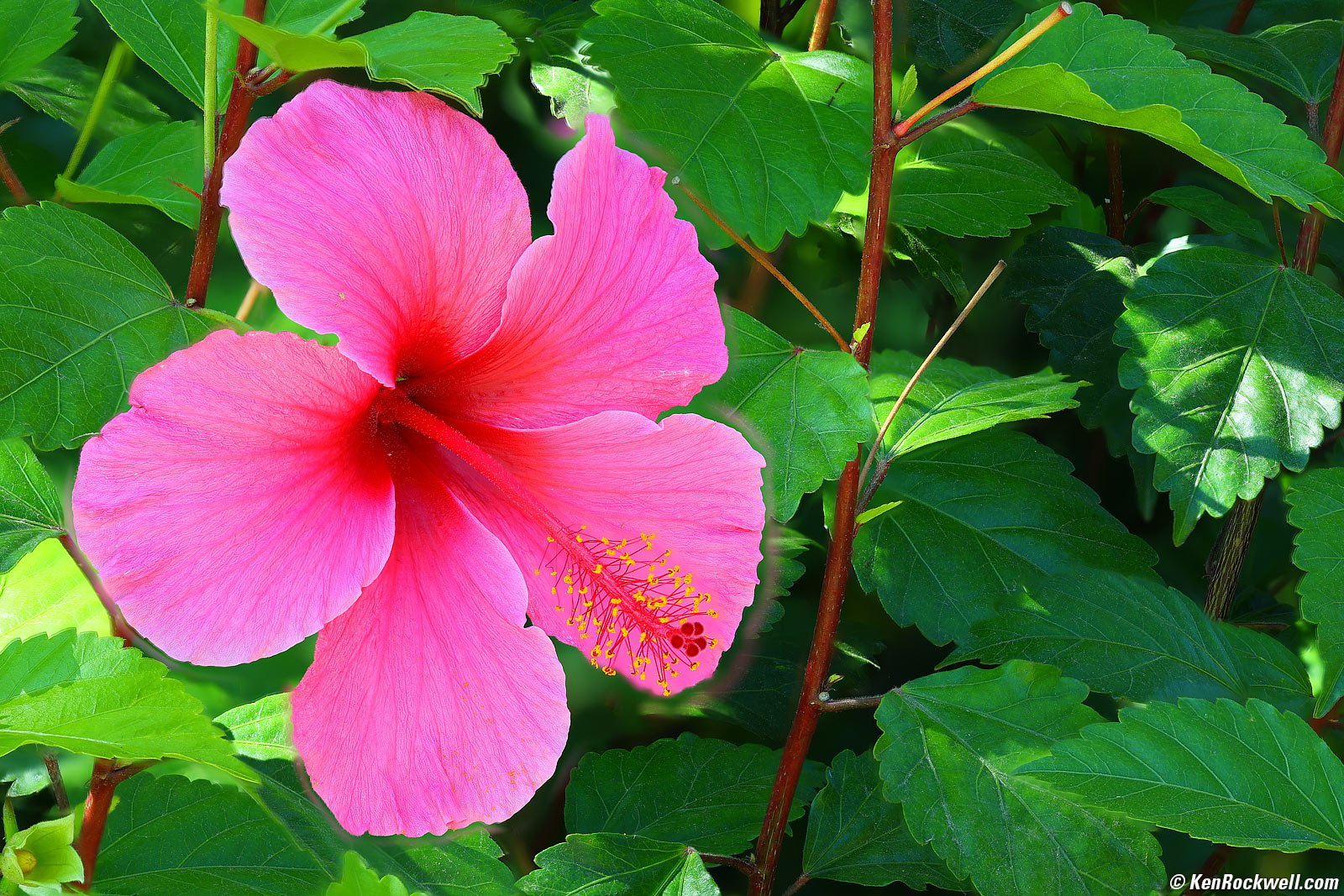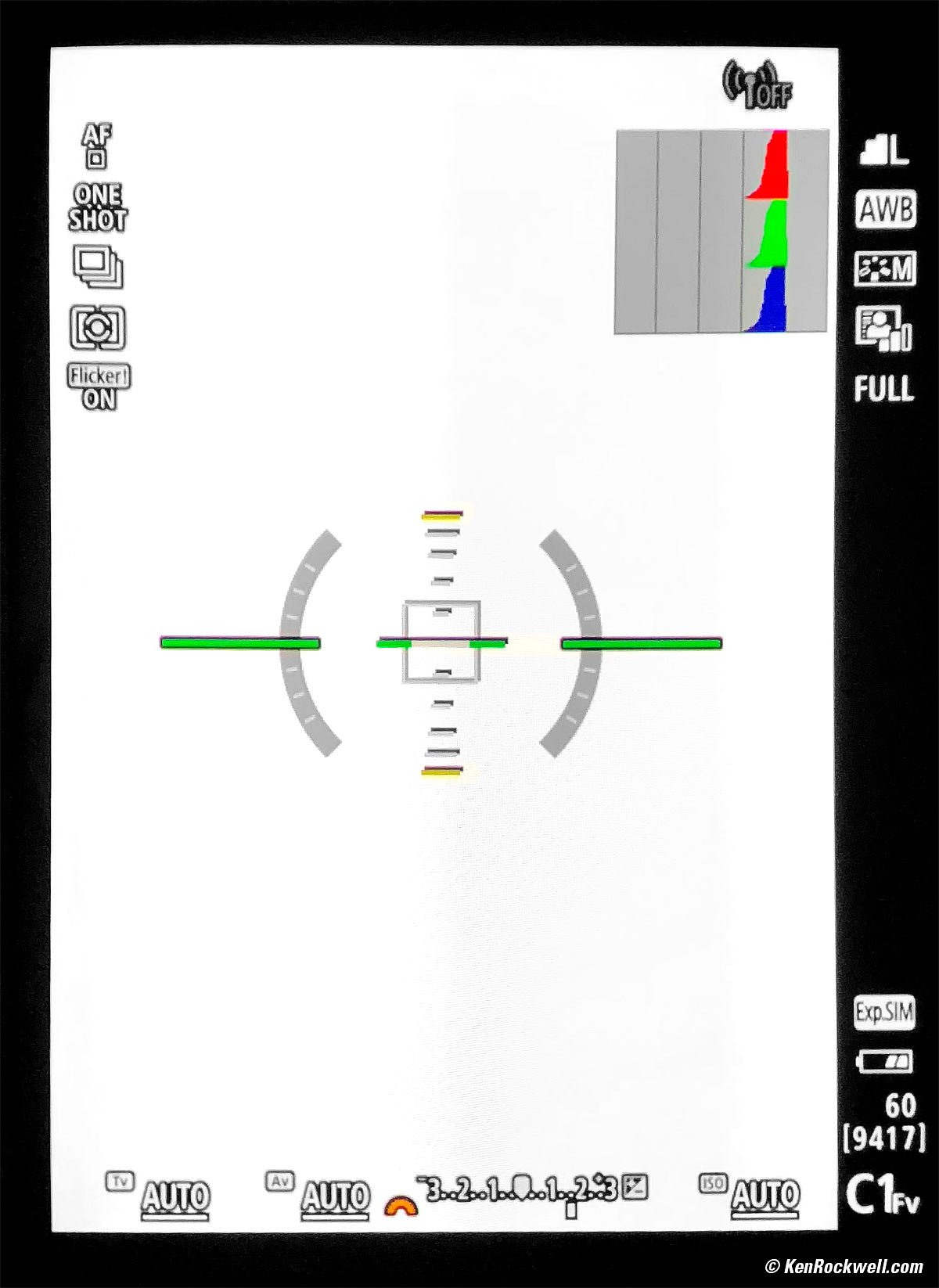Canon EOS R8 User's Guide
< < Back to EOS R8 Review
Introduction Power Format Card Menu System
My Menu Mode Dial Fv Exposure Mode
Autofocus Manual Focus Peaking
Focus Magnifier Manual Focus Override
Focus Bracketing and Depth Compositing
ISO Getting ISO 50 (L) & 204,800 (H)
White Balance Exposure Compensation
Customize the Finder & Rear LCD
Electronic Shutter & Silent Mode
Live Color Histograms Display Brightnesses
Vertical Finder Quick Control Screen
Picture Styles Image Tweaks HDR File Formats
Getting 40 FPS Lens Corrections
C1 & C2 Preset Modes My Own C1 & C2 Settings
Non-EF Lenses on Adapters Video
Canon's Own EOS R8 User's Manual
R3 R5 R5C R6 II R6 R R8 RP R7 R10 R50 R100
Bodies Compared RF Lenses EF Lenses Flash
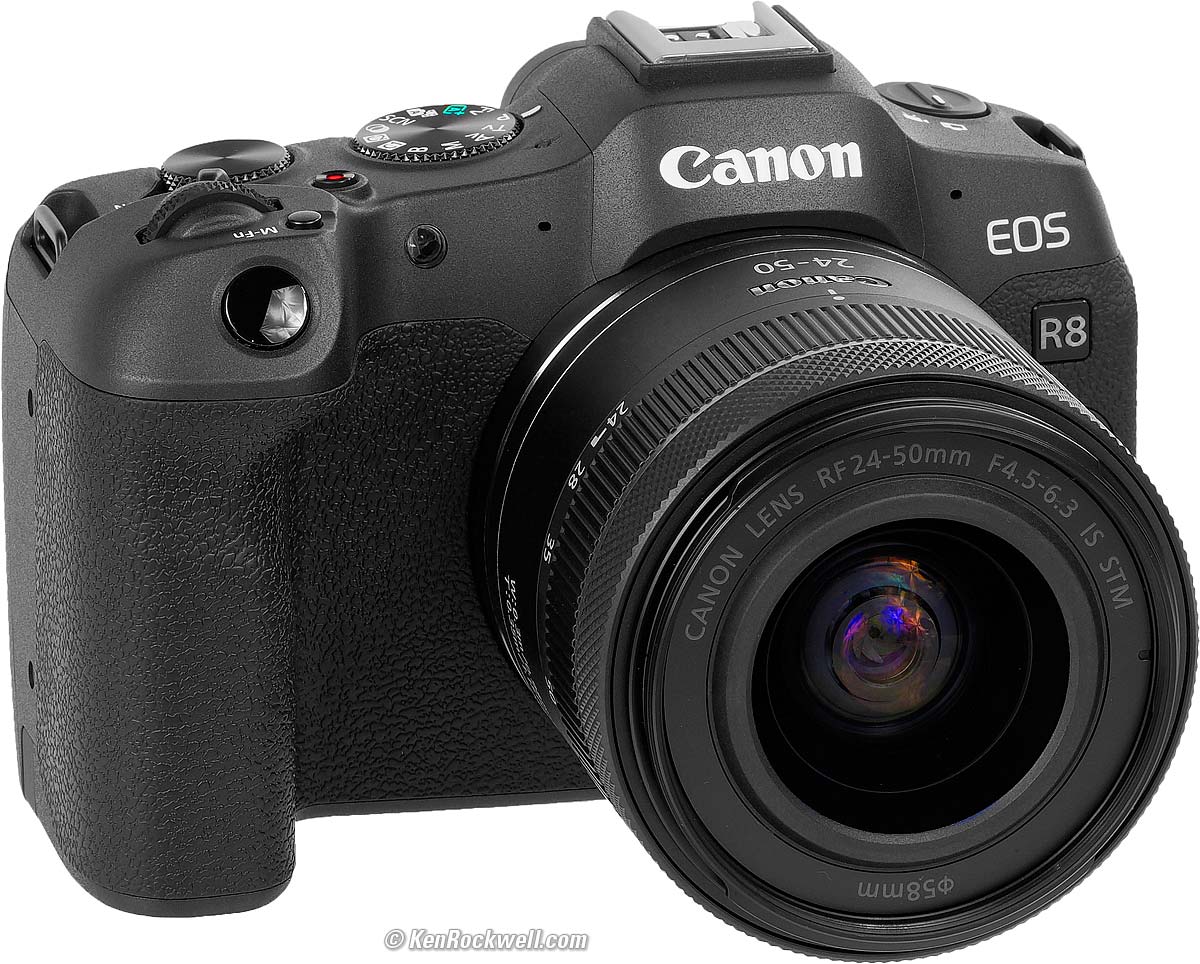
Canon EOS R8 (16.3 oz./461g with battery and SD card, $1,499) and RF 24-50mm IS STM. bigger.
If you find this guide as helpful as a book you might have had to buy or a workshop you may have had to take, consider helping me write more of these with a gift of $5.00 — especially if you intend to make a printout of this copyrighted work.
This all-content, junk-free website's biggest source of support is when you use those or any of these links to my personally-approved sources when you get anything, regardless of the country in which you live. Canon does not seal its boxes in any way, so never buy at retail or any other source not on my personally approved list since you'll have no way of knowing if you're missing accessories, getting a defective, damaged, returned, non-USA, store demo or used camera. Get yours only from the approved sources I use myself for the best prices, service, return policies and selection. Thanks for helping me help you! Ken.
August 2023 Canon Reviews Mirrorless RF Lenses EF Lenses Flash All Reviews
Canon's own EOS R8 User's Manual PDF
|
I buy only from these approved sources. I can't vouch for ads below. |
Introduction top
This is a plain-English guide to how I use my Canon EOS R8. If you want all the excruciating details, refer also to Canon's own EOS R8 User's Manual.
This will teach you to be an expert on the EOS R8's controls and menus. It also includes a lot of tips, tricks, and the settings I prefer to use.
To get great photos you still need to get yourself to the right place at the right time and point the camera in the right direction, which is a lot harder than mastering the settings of the R8. Right out of the box at default settings, the R8 does a great job all by itself. Making a great photo involves timing, FARTing, knowing the critical basics of what makes a great photo and a whole lot more.
If you really want to take great pictures, this guide won't help you if you can't already. This will teach you how to operate a camera; making great pictures is a very different pursuit. Just as I can write an article to teach you how to play a piano — it's just pressing the keys and pedals — your ability actually to play a piano is an entirely different subject.
Here we go:
Power top
There is no battery percentage indication; just a 3-segment battery icon.
For all-day shoots I'd suggest carrying a spare LP-E17 battery.
It charges over USB-C or in the included external charger. You don't need the external charger unless you have a spare battery, in which case each night you charge one in the camera and the other in the charger.
The external charger plugs in the wall with a flippy plug, while the camera needs to charge from a USB-C source like a USB-C PD charger, a USB-C PD power bank or even a USB-C PD solar panel.
It works great charging from a USB-C source with any USB-C to USB-C cable, but won't charge with a USB-A to USB-C cable from an old-style USB-A source.
The battery door has to be closed to charge in-camera.
Canon suggests the optional $190 USB Power Adapter PD-E1, which only charges the battery.
Battery Charger LC-E17
Battery Charger LC-E17. bigger.
The included folding-plug Battery Charger LC-E17 lights a STEADY AMBER LED while charging and a STEADY GREEN LED when done.
A FLASHING AMBER LED means the battery isn't charging; take it out, unplug the charger, plug it all back in and try again.
Format Card top
I do this every and any time I put a card in my camera, presuming of course that I've downloaded everything from my card.
To format the card, MENU > WRENCH page 1 > Format Card > OK.
Menu System top
NOTE: Many of the menu options I describe below are not available in the [A+] AUTO mode as set on the exposure mode dial. Be sure to use any of mode other than [A+] AUTO, movie or SCN to have access to all the settings I describe.
Pressing MENU on a sleeping camera simply wakes it. Just press twice, slowly, if the camera is off to get to MENU.
Pressing the INFO button while in MENU jumps directly to the next color-coded set of main menus (CAMERA, AF, [▶] PLAYBACK, <~> (network settings), WRENCH, CUSTOM and MY MENU (★)).
Use the right-left buttons or the front dial to move between the pages inside each colored category.
Use the up-down buttons or the top right (rear) dial to move up and down in each menu page.
My Menu top
I add these items to MY MENU (★). Of course your needs will be different:
Battery Info: Gives me just a little bit more information than the icon does.
ISO speed settings: This is where you can unlock ISO 50 (L) and 204,800 (H) and program the particulars of AUTO ISO.
Shutter Mode: This is where I choose Electronic so I can get to 40 FPS or First-Curtain so I can use flash.
Screen brightness: This sets the LCD brightness. Setting the LCD to max works very well in direct sunlight; give it a try.
Custom shooting mode (C1, C2): I use this to save and modify the C1 and C2 settings selected with the MODE dial.
Lens aberration correction: I leave these all ON, except I may turn Distortion Correction OFF if I'm not shooting buildings, straight lines, or shooting with a fixed, distortion-free lens like the RF 50mm f/1.2L.
Exposure Mode Dial top
Just turn the dial to set exposure modes.
By default the EOS R8 calls up some colorful graphics (guides) on the LCD and in the finder to help newcomers understand all the modes, but these graphics get in the way when you just want to change the dial and mode quickly.
Once you learn these you can set the modes instantly by disabling the fancy graphics at:
MENU > WRENCH page 2 > Mode guide > Disable.
Fv Exposure Mode top
Try this new exposure mode. I really like it because it makes it easy to set shutter, aperture, compensation or ISO manually if you need to, and return to auto selection just as easily.
Fv mode is like Program mode, but lets you set individually any of Shutter, Aperture, Exposure Compensation or ISO, while the others continue to set themselves automatically. You can set more than one at a time, and those you don't set will change automatically as needed. Cool, huh?
Select Fv on the big top MODE dial and shoot; it's all automatic unless you change something.
If you want to change something, turn the rear dial to select what you want to change and turn the top dial to change it. The finder or rear LCD shows an orange wheel to the left of what's selected for adjustment. Once you set one item you can set other things by turning the rear dial to select them.
The front dial will change Exposure Compensation in this example below:
Canon EOS R electronic viewfinder (same for rear LCD). bigger. The orange dial is left of exposure compensation, which will change when you turn the front dial. Turn the rear dial to move the orange dial icon to select other items to set.
The display underlines whatever the camera is controlling automatically, and has no underline for what you've set manually. Simple.
Unlike Program mode which resets any Program Shift as soon as the meter turns off, Fv settings don't reset even if you turn off the power. Your settings stay until you clear or reset them yourself.
Tap down on the rear 4-way controller to reset everything back to AUTO. You can reset individual items back to AUTO by selecting them and then pressing down, left or right on the four-way rear controller.
Even if you change something like Exposure Compensation by some other method like the lens' control ring, a tap on the rear controller will reset it back to AUTO.
Oddly in the Fv mode Auto ISO seems to ignore any auto or manually set minimum shutter speeds below about 1/60. Weird, but it has been this way ever since Canon invented the Fv mode.
Autofocus top
AF Modes
There are two main autofocus modes: ONE SHOT and SERVO. AI FOCUS looks at the subject and automatically picks one of the other two modes accordingly.
ONE SHOT means the EOS R8 focuses once and locks. Use this for still subjects.
SERVO means the EOS R8 continuously autofocuses and tracks moving subjects.
AI FOCUS lets the R8 pick one of the other two modes automatically.
You can set these by pressing the Q/SET button, or at MENU > AF page 1 > AF operation.
AF Area Color
Blue boxes mean tracking SERVO AF.
Green boxes mean LOCKED ONE-SHOT autofocus.
Gray means unfocused.
Setting the Touch Screen to select AF areas, especially when using the finder
Set this and you can swipe your finger around the touch screen as you're looking through the finder for far faster, easier and more precise positioning of the AF area than messing around with the clicker. You can use the 4-way rear clicker if you insist, but this works so much better:
MENU > AF page 4 > Touch & drag AF settings > Touch & drag AF > Enable,
MENU > AF page 4 > Touch & drag AF settings > Positioning method > Relative, and
MENU > AF page 4 > Touch & drag AF settings > Active Touch Area > Right. Depending on which eye you use and what part of the screen is away from your nose you might prefer a different area. This prevents your nose from selecting the AF areas!
I leave the camera set to All Area/Face detect, and presuming the Touch Screen is active as set above, just touch the screen to select one area and move the AF area around, even if you're looking through the finder.
Swapping between Touch LCD selection and Auto AF Area Selection
This is easy: I prefer to use Auto Area, and only if my EOS R8 isn't selecting the correct area automatically I then will manually select an area by simply tapping the touch LCD.
The bad news is if I tap the LCD by accident my R8 will then be tracking based on whatever random area I accidentally selected, and unlike in the RP where the Trash button cancels this feature and returns to Auto Area (or whatever else you've selected), you either have to take your eye away from the finder and then tap the [ OFF ] icon on the top right of the rear LCD, or tap the MENU button twice.
Selecting AF Area Modes Quickly
I remove all the AF modes I don't use at MENU > AF page 4 > Limit AF areas > and uncheck all that I don't use (I use only the 1-Point AF and Whole Area AF options).
There are many ways to select among these AF Area modes. I prefer to tap the M-Fn button and use the rear dial to select among the AF Area modes.
Eye Detection
Eye Detection means the EOS R8 focuses on the nearest eyeball. It's not eye-controlled AF-area selection like in the EOS R3 and 35mm EOS 3.
I set EYE AF and leave it on: MENU > AF page 4 > Eye Detection > Auto.
Setting Tracking Autofocus and Exposure top
Tracking AF in Continuous Advance Mode
Be sure to select SERVO AF at MENU > AF page 1 > AF operation, or in the Quick Control screen (press SET Q), the M-Fn button or any other screen it appears.
It won't track focus if you leave it in ONE SHOT.
If things are moving it will probably automatically select SERVO AF if you're set to AI FOCUS.
Tracking Exposure in Continuous Advance Mode
Not only do you have to select SERVO AF to get tracking autofocus, you also have to select SERVO AF for exposure to track from frame to frame in Continuous advance mode!
Weird, but true. Leave AF in ONE SHOT and exposure locks at the first frame, along with focus.
Exposure only tracks (changes) from frame-to-frame if you're in SERVO autofocus.
If things are moving it will probably automatically select SERVO AF if you're set to AI FOCUS.
How to Lock Focus and Exposure in Continuous Advance mode
Weird, but true, set ONE SHOT AF in the Quick Control or any other screen and the EOS R8 will lock both focus and exposure at the first frame of any sequence shot in Continuous advance mode.
Manual Focus Peaking top
If you want this, set this at MENU > AF page 5 > MF peaking settings > Peaking > ON. It's OFF by default.
Focus Magnifier top
By default tap the AF Area mode button [ + ] (below the ✱ button) and then tap INFO to magnify.
I set my AF ON button to be a direct focus magnifier at MENU > CUSTOM page 3 > Customize buttons > Camera Column > AF ON :> Magnify.
HINT: While using a focus magnifier, you can select the magnified area before you magnify, and once you've magnified it you can user the rear 4-way clicker or swipe the rear LCD. Good luck; it's much easier to select the area before you hit magnify.
Manual-Focus Override top
By default, there is no always-responsive instant manual-focus override as we take for granted in our DSLRs.
To get this, but only in ONE SHOT (or AI FOCUS if things hold still) AF mode, we need to set:
MENU > AF page 6 > Lens electronic AF > to either "One‑Shot‑> enabled" or "One‑Shot‑> enabled (magnify)"
or otherwise the focus ring is always ignored in AF. Canon should have it set this way by default, but they don't. No big deal now that I figured it out.
Now manual focus override works if you turn the ring while continuing to hold the shutter halfway, but only after focus locks in ONE SHOT.
Focus Bracketing, Stacking & Compositing = Infinite Depth-of-Field top
There is a trick in the EOS R8 that lets us get unlimited depth of field by letting the R8 shoot a series of focus-bracketed shots and then compositing the sharpest parts of each into one final ultrasharp image (samples at that link).
This process has many names, including Pan Focus and Focus Stacking.
One Frame of Many. bigger. |
In-Camera Composite of 100 Frames. bigger. |
See more samples in my R8 Review. © camera-original composite from about 100 frames.
This is very simple today. To make a series of focus-bracketed shots that are composited into one final image, go to:
MENU > CAMERA page 6 > Focus bracketing:
and set:
Focus bracketing: enable.
Number of shots: 100 (default). Set this to taste if you like. You may need a larger number if you shoot at a large aperture or use a small focus increment; adjust to taste.
HINT: If it's shooting so many images that it's reaching far into the background that you don't want in focus (as in the flower photo above), use a smaller Number of shots.
Focus increment: 4 (default). Set this to taste if you like.
Exposure smoothing: enable (default). This evens-out differences in brightness between shots.
Depth composite: enable. This tells the R8 to assemble the best sections of every image into one final, usable, ultrasharp image all by itself.
HINT: If you forget to set Depth composite to enable so the R8 does it itself, you'll have to go back to the stone age and do it manually in a computer later.
Crop depth comp: enable. This crops edges that might not be in all the shots.
Canon suggests a tripod, but my R8 works great even hand-held.
If you're on a tripod, use the lowest ISO you can like ISO 50 (L) or ISO 100, even in the dark, for the sharpest results. You should turn off Image Stabilization when on a tripod, but it probably works fine either way.
Canon suggests using one of the newest STM lenses, but I usually use my USM Canon EF 180mm f/3.5L Macro which came out in 1996 and it works flawlessly, even hand-held!
Set a moderate aperture like f/8, although any aperture should work. Smaller apertures like f/22 soften the image due to diffraction, and wider apertures like f/2.8 may require many more shots and processing time to do the same thing.
Use available, natural or continuous lighting. I don't know that I'd use flash or studio strobes as 1.) you'd be using a lot of flash pops, and 2.) I don't know if the EOS R8 will wait or can be set to wait after each exposure for flash or strobes to recycle.
Be sure your lens is set to AF and the camera is in SERVO, AI FOCUS or ONE SHOT autofocus. Don't set your lens to MF (Manual Focus) or this won't work because the lens won't focus.
Focus your camera on or slightly closer than the closest part of the scene, and press the shutter. The EOS R8 will now make a silent series of many images from your near focus out to a long way away. It's usually smart enough to make fewer than your preset Number of shots if it doesn't need them all. The reason to set a lower Number of shots is to make it stop once it's shot out to the longest distance you want in focus, otherwise it tends to run all the way out to near infinity. Experience may show you what's a good number for your typical setups.
The final composite image uses the time-stamp of the first image in the series and is file-numbered one more than the last image in the series, if that helps you find the final composite image.
The Old-Fashioned Offline Way for Hackers
In olden days before the R8 we had to use Canon's free Digital Photo Professional software to composite all the images together later in our computer.
I haven't bothered with this since 2019 since it's a pain, however one advantage to doing this the hard way is that you can select which images to use for the composite which lets you control the in-focus region precisely. Exclude images that have in-focus regions you want to remain soft.
If you prefer to do this on your computer, then:
1.) Load all the images into your Mac or PC.
2.) Open Canon's free Digital Photo Professional software, at least version 4.10.0 in which this feature was introduced.
3.) Find and select the group of images you want to process. Even if you shot a lot of images it helps to preview them and only include the ones that include the range of focus (depth of field) you want. Often you'll have many images that focus too far away and past your subject. If you don't include them it runs much faster. Ditto if any images are in-focus on distracting foreground elements; don't select those images and the system won't make the foreground in focus.
You can control the look of the background by including or excluding the images that have the background in focus. Select only the images with the desired subject in focus and that will give a super-sharp subject and nice, soft background. Choose all the images and it will make the background sharp, if there are shots with the background in focus. Obviously you get to choose this after you've shot, and can try it anyway you like until you get exactly the look you want.
4.) From your computer's top menu bar select TOOLS > DEPTH COMPOSITING > Start Depth Compositing tool. Leave all on defaults.
5.) Your computer makes a new folder with data, and saves a new "Depth Composited" image called DC_IMGxxxxx in the originally folder. You're done!
My 8-core 3GHz 32GB RAM Mac Pro (late 2013) on OS 10.14.3 Mojave draws about 160W from the wall and its fan spins at 1,030 RPM, up from its usual draw of 60~100W and 780 R8M fan for most other uses. You'd never notice it, but the computer does have to chew on all this math with running the program.
6.) I delete the folder with the extra data. I'm unsure why you'd want to save this, unless it helps you process the same image again.
The results aren't always perfect; if I have a subject in front of a detailed background and let the camera focus-bracket all the way to include a very distant background, the composited result may look weird at the subject's edges, especially if your lens changes image size as focus (breathes). No problem, run the software again but exclude the images that are focused on the background.
I've wondered if focus breathing (the image changing size as focused) would lead to distortion, but I haven't looked for it.
ISO top
There's no marked ISO button but many ways to set it.
I change ISO from within the Fv mode or I use the M-Fn button. I also will use the Q-touch screen (use the Q/SET button), and of course you can set ISO at MENU > CAMERA page 2 > ISO speed settings, which I also add to my My Menu menu.
I almost always shoot in AUTO ISO unless I'm on a tripod. I set AUTO ISO so it can select anything from ISO 100~51,200 (MENU > CAMERA page 2 > ISO speed settings > Auto range).
For people, groups and portraits I set Auto ISO Minimum Shutter Speed to 1/125 (MENU > CAMERA page 2 > ISO speed settings > Min. shutter spd.).
For sports and action I set Auto ISO Minimum Shutter Speed to 1/500 to 1/1,500 depending on what it takes to freeze the action at hand.
For everything else that holds still I set Auto ISO Minimum Shutter Speed to AUTO, which varies by itself depending on focal length. If I have a stabilized lens I'll set this two clicks slower at (MENU > CAMERA page 2 > ISO speed settings > Min. shutter spd. > Auto > (turn front dial two click to the left for Auto (-2)).)
Oddly in the Fv mode Auto ISO seems to ignore any auto or manually set minimum shutter speeds below about 1/60. Weird, but it has been this way ever since Canon invented the Fv mode.
Expand or Limit the Range of ISOs top
You have to go here to enable ISO 50 (L) and ISO 204,800 (H). Set this at:
MENU > CAMERA page 2 > ISO speed settings > ISO speed range.
This has always been a weirdness with Canon: you have to go here to enable the highest and lowest ISOs, and while you're here you instead can limit them further, for instance, make only ISO 400 through ISO 1,600 work. The only reason I can fathom for this is if you give it to your mom and don't want her accidentally setting ISO 51,200 in daylight.
White Balance top
I almost always shoot in Auto White Balance (AWB): Ambience priority.
Exposure Compensation top
Like every other EOS camera, the back (top right) dial adjusts exposure compensation at any time, unless you program it otherwise.
You can program an extra lens control ring to become exposure compensation — or use the M-Fn button.
Multi-Function (M-Fn) Button top
The M-Fn button near the shutter button is one of many ways to set WB/Metering, Advance mode/AF Mode, Flash Comp./ISO and Picture Style/AF Area mode.
Tap the M-FN button to wake it up and/or select among four combinations of settings. Move the front or rear dial to set what you're going to set, then tap the shutter to return to shooting.
Easy!
You can program the functions hidden inside the M-Fn button at:
MENU > CUSTOM page 3 > Customize buttons > M-Fn > (leave it at DIAL FUNC) > press the INFO button > now you can select any of the eight positions and then select which function you would like in that spot.
And of course you can reprogram the M-Fn button to be another single-purpose button, and you can program other buttons to behave as a multi-function M-Fn button, described next:
Customizing Controls top
Customize Buttons
Set these at MENU > CUSTOM page 3 > Customize buttons.
HINT: I prefer to set my left rear clicker to MENU, so I can set my MENU without having to reach all the way over to the real MENU button on the left side of the camera. You can set the other clicker directions as well, which by default reset Fv functions to AUTO.
HINT: I program the red button next to the shutter button to set the cropping (aspect ratio). To shoot movies, I turn the top left switch to MOVIE and use another button to start recording instead.
HINT: The M-FN button does its magic because its set to DIAL FUNC; you can set it to other things.
HINT: You can set the ✱ button to do what the M-FN button did by default if you set it to DIAL FUNC.
Customize Dials and Lens Rings
Set these at MENU > CUSTOM page 3 > Customize dials.
There are three rings or dials, but not that many functions to which to set them.
The options that also show a down arrow mean that the ring is only active during a half-press of the shutter to prevent accidental adjustment.
Customize the Finder & LCD top
You can select what gets displayed at MENU > CAMERA page 9 > Shooting info. disp.
You can program up to five different sets of preferred displays at MENU > CAMERA page 9 > Shooting info. disp. > Screen info. settings > INFO button.
Once set, you select among these sets while shooting by pressing the INFO button repeatedly.
If you'd rather just have one or two sets, you can disable the extras by unchecking the others at MENU > CAMERA page 9 > Shooting info. disp. > Screen info. settings.
You can set quite a few different kinds of displays, you can set different ones for the LCD and for the finder, and even select the sizes of the image at MENU > CAMERA page 9 > VF display format.
Drive Modes top
The easiest way to select among Self Timer, Single, Continuous, Continuous High, etc. is to tap the M-Fn button until the Drive Mode icon is highlighted and then turn the front dial to select them. Tap the shutter halfway to return to shooting.
You also can press the rear Q/SET button and find the advance mode settings on the rear LCD, or do it old-school at:
MENU > CAMERA page 7 > Drive mode.
Electronic Shutter & Silent Mode top
Silent shooting is set at:
MENU > CAMERA page 7 > Silent shutter function
or
honestly I just go with the electronic shutter at:
MENU > CAMERA page 7 > Shutter mode > Electronic.
Also you can select SCN on the mode dial, press Q/SET, select the screen's top left icon, select Silent Shutter, and you're there. Oddly using this way locks many of the R8's settings as typical for SCENE modes, so if you're curious enough to be reading this guide, I'd skip this method.
Long Exposures: Bulb Timer top
The EOS R8 makes precisely timed exposures of any length up to 100 hours, with no need for a remote cord or app! You use the BULB setting and program a Bulb timer for how long you want that exposure. Easy!
1.) Set the top mode dial to BULB (B)
2.) Set the Bulb timer at MENU > CAMERA page 7 > Bulb timer. In that menu set it to Enable and then you can press INFO to set the hours, minutes and seconds for your exposure. (The Bulb timer option is grayed-out unless the mode dial is at B.)
HINT: Set your Drive mode to Self Timer and you won't need to use a remote cord to eliminate camera shake!
4.) It will make an exposure while counting-up the elapsed time on the rear LCD and then close the shutter after your programed duration. If you want to end the exposure early, just tap the shutter again.
Since it closes the shutter early on a second press, you can reprogram BULB to TIME by setting a very long value for Bulb timer, but you do have to enable the Bulb timer each time you go into Bulb mode.
The EOS R8 shows the elapsed time as MMM:SS on the rear LCD as it exposes.
Flash top
The EOS R8 works perfectly with all EX-series flash. It has the same I-TTL II flash system as Canon's SLRs and DSLRs.
You can save money with old used flash which work as well as the newest flashes. I use my 580EX II (about $85 used if you know How to Win at eBay) when I want a lot of power, or my 320EX (about $50 used if you know How to Win at eBay and also available used at Amazon) when I'm traveling light.
The R8 also has the new 21-pin Multi Function contacts to work with the EL-5 and any newer flashes that lack traditional 5-pin contacts.
Live Color RGB Histograms top
Few cameras other than Canon can show a live color histogram so it can help you before you shoot. Most other brands of cameras, and the R8 by default only show a useless B&W histogram, but set this below and you can get a live RGB histogram in the upper right (in this photo the image is plain white so you don't need the RGB histogram, but you get the idea.) Color histograms are needed for color photography to avoid overexposing anything with color.
Set this at
MENU > CAMERA page 9 > Shooting info. disp. > Histogram disp > Brightness/RGB > RGB.
I prefer to make the histogram smaller so I don't take up too much of the screen, which I set at
MENU > CAMERA page 9 > Shooting info. disp. > Histogram disp > Display size >Small.
Display Brightnesses top
Set these at MENU > WRENCH page 3 > Screen brightness and MENU > WRENCH page 3 > Viewfinder brightness.
I always use AUTO for viewfinder brightness.
Since the rear screen brightness has to be set manually, you may want to set different screen brightnesses in the C1 and C2 presets to save and recall your brightness preferences so you can use one for outdoors and one for indoors. Easy!
Vertical Finder Display top
I set my finder data to rotate when held vertically! Set this at MENU > CAMERA page 9 > Shooting info. disp. > VF vertical display > ON:
Actual view through Canon EOS R Electronic viewfinder. (The EOS R8 is similar and it's much sharper in actual use than in this special photograph.)
I've turned on almost every display option here; just press the INFO button a few times to get a clear window through which to compose if you prefer.
Quick Control (Rear) Screen top
Press the INFO button a few times while using the LCD to get this. This is one of many ways to make a lot of shot-to-shot settings.
Once the Q screen is up, you either have to tap the "Q" on the touch screen to use the touch screen, or press the Q/SET button and use the rear 4-way controller to navigate around it.
This Quick Control screen oddly is only available while looking at the rear LCD; it won't appear in the finder.
Picture Styles top
"Picture Styles" are where we program sharpening, color saturation, contrast and etc.
Set these at MENU > CAMERA 4 > Picture Style, among other places you can find this or assign it to a button.
I photograph places and things in the STANDARD [*S] Picture Style setting. I change the saturation to +4 and set sharpening to 7, 1 and 1.
For pictures of people I use the same sharpening, but leave saturation at 0 or +1.
More Image Tweaks top
I always set the shadow optimizer (Automatic Lighting Optimizer) to:
MENU > CAMERA page 2 > Auto Lighting Optimizer > Standard.
I don't use highlight recovery (Highlight Tone Priority), since it deactivates the shadow optimizer above.
HDR Mode top
Set the HDR mode at MENU > CAMERA page 2 > HDR Mode.
File Formats top
I shoot at LARGE JPG, and set it to NORMAL (▟ stairstep icon) instead of the default of FINE (quarter-circle icon). The pictures look the same, but take up half the file space and twice as many fit on a card and they download twice as fast.
For people and event photos or anything where I'm shooting a lot of images where I don't need 24 MP LARGE, so I'll shoot at MEDIUM (11 MP) to make everything work much faster in post-production.
I never shoot raw, but you may do whatever you like.
Getting Still Photos at 40 FPS top
The EOS R8 only runs above 6 FPS with its Electronic Shutter. See the full list of frame rates and settings.
Set the shutter mode at
MENU > CAMERA page 7 > Shutter mode > Electronic.
Exposure only tracks (changes) from frame-to-frame if you're in SERVO autofocus (or if AI FOCUS selects SERVO for you).
Fast Finder Update Rate before Rolling Video top
When the top left dial is set to VIDEO mode, by default the finder reverts to a slow frame rate while you're not rolling video to save power. This is the
MENU > CAMERA page 8 > Standby: Low res. > ON setting.
For smoother finder motion while video isn't rolling, set:
MENU >CAMERA page 8 > Standby: Low res. > Off.
Regardless of this setting, the finder updates fast for smoother motion when you're rolling at the higher video frame rates, and never updates at faster rates if you're set to shoot at the slower video frame rates.
Lens Corrections top
Corner darkening, distortion and more are usually corrected by default.
You can usually can switch any of these three corrections off at MENU > CAMERA page 2 > Lens aberration correction, except with some more basic lenses where Canon won't let us turn off distortion correction.
If you turn off the Digital Lens Optimizer (DLO), you're offered à la carte options of reactivating lateral color fringe correction and/or diffraction correction without the rest of the DLO.
The only reason to turn off the DLO or others if if for some reason these are using too much processor power and slowing down the camera. I've never seen this happen, but if it concerns you, you probably don't need distortion correction when shooting portraits.
C1 & C2 Modes top
These are two programmable spots on the top dial. Program them, and everything about the camera is instantly recalled, making it one-click to swap between any two completely different sets of settings.
I live by these. I set C1 for photos of places and things and C2 for people — or for sports and action. Everything about the camera: EVF and LCD brightness, Saturation, frame rates, AF modes, resolution, and everything magically recall with the click of a dial.
Each time you turn the dial to one of the C1 or C2 positions, everything is reset to what was stored in that position.
Feel free to change any settings as you shoot in the C1 or C2 positions. You won't erase what you saved. These changes will stay until the camera times-out, usually one minute (you can change that duration in the menus), and the next time you go to shoot, even if you had changed something, you're back at your saved settings.
If you want to return to the saved settings more quickly, just move the dial to any other position and return.
To Save a Suite of Settings
To save a complete camera-state setting of your EOS R8:
1.) Set the camera as you like. Everything is saved.
2.) Press:
MENU > WRENCH page 5 > Custom shooting mode (C1, C2) > Register settings > choose C1 or C2 > SET > OK.
Permanently Change a Stored Setting
To change a stored setting:
1.) Set the dial to the setting you want to change (C1 or C2). This recalls that setting.
2.) Change something.
3.) Save the camera's current state back into that dial position:
MENU > WRENCH page 5 > Custom shooting mode (C1, C2) > Register settings > choose C1 or C2 > SET > OK.
If you select the wrong C1 or C2, you will have overwritten the settings at that position.
Copy a Stored Setting
To copy a stored setting into the other location:
1.) Set the dial to the setting you want to copy into the other position. This recalls that setting.
2.) Save the just-recalled camera state into the other dial position:
MENU > WRENCH page 5 > Custom shooting mode (C1, C2) > Register settings > choose C1 or C2 > SET > OK.
If you select the wrong C1 or C2, you will have overwritten the settings at that position.
Make a Temporary Change to a Stored Setting
Just change something as you would anywhere else. By default, the next time the camera wakes up or you re-select that setting, it will be back as it was saved. The C settings are not altered unless you deliberately save something into them as described above, or if you set:
Have C1 & C2 Settings Update Automatically
The EOS R8 resets the C1 or C2 settings each time it turns on or you reselect C1 or C2, unless you set:
MENU > WRENCH page 5 > Custom shooting mode (C1, C2) > Auto update set > Enable.
Now each setting updates as you change it. If you select another mode and come back to that mode it will be as you last left it.
New-Camera Setup
When I get a new camera I set everything as I want it.
I then save it to C1.
I change what I want about it for C2, and save it to C2.
I then select MENU > WRENCH page 5 > Custom shooting mode (C1, C2) > Auto update set > Enable so that everything updates as I use and get familiar with my new camera. After I'm confident that my camera's presets are all as I want them, I then set MENU > WRENCH page 5 > Custom shooting mode (C1, C2) > Auto update set > Disable so my preferred settings are fixed.
My Personal C1 & C2 Settings top
Everything about the camera is saved into each of these C1 or C2 memories. This is what I save that changes for me from setting to setting:
C1 |
C2 |
(or alternately for Sports & Action) |
|
Used for |
General Scenics |
People & Family |
Sports & Action |
Exposure Mode |
P or Fv |
P or Fv |
P or Fv |
Resolution |
L (24 MP) |
M (11 MP) |
M (11 MP) or S1 (6 MP) |
Picture Style |
Standard with +4 Saturation and 7, 1, 1 sharpening |
Standard with 0 or +1 Saturation and 7, 1, 1 sharpening |
Standard with 0 or +1 Saturation and 7, 1, 1 sharpening |
ISO |
Auto |
Auto |
Auto |
Max Auto ISO |
51,200 |
51,200 |
51,200 |
Minimum Auto ISO Shutter Speed |
AUTO for the slowest possible hand-held speed that lets the camera use the slowest possible ISO for the sharpest pictures. If the lens has IS, I'll shift this to AUTO -2 Slower. |
1/125 to freeze people talking |
1/500 ~ 1/1,600 or whatever it takes to stop the action |
AF Mode |
AI FOCUS so it selects the mode by itself, or ONE SHOT if I know nothing's moving. |
SERVO AF |
SERVO AF |
AF Area Select* |
Whole area AF | Whole area AF | Whole area AF |
Finder Level |
ON |
Off |
Off |
1st-curtain electronic |
1st-curtain electronic |
Electronic |
|
Usually not |
No |
||
Advance |
Continuous Low (3 FPS) |
Continuous Low (3 FPS) |
High or High+
(20 or 40 FPS) |
* If the camera isn't finding the subject by itself, I'll switch to 1-point AF.
Non-EF Manual-Focus Lenses on Adapters top
The EOS R8 works flawlessly with Canon EF Lenses on Canon EF to RF Adapters because all the electronics talk to each other properly.
However, with Canon FD and other random manual-focus lenses on random adapters there are no electronic contacts so the EOS R8 thinks there is no lens attached and so it won't take pictures.
To get the EOS R8 to shoot with randomly adapted lenses, set MENU > CUSTOM page 4 > Release shutter w/o lens > ON. This is OFF by default.
Use the Av or M exposure modes. Exposure will be poor in Fv, P or Tv modes because the EOS R8 can't control the aperture of an non-electronic adapted lens.
Video top
In the most basic setup, tap the top red (movie) button to start and stop video recording. Since I set my red button to set the aspect ratio, I turn the top left dial to VIDEO and then use the red button on the top right of the rear LCD to start and stop.
Most video settings are at MENU > CAMERA page 10.
© Ken Rockwell. All rights reserved. Tous droits réservés. Alle Rechte vorbehalten. Alla rättigheter förbehållna. Toate drepturile rezervate. Ken Rockwell® is a registered trademark.
Help Me Help You
I support my growing family through this website, as crazy as it might seem.
The biggest help is when you use any of these links when you get anything. It costs you nothing, and is this site's, and thus my family's, biggest source of support. These places always have the best prices and service, which is why I've used them since before this website existed. I recommend them all personally.
If you find this page as helpful as a book you might have had to buy or a workshop you may have had to take, feel free to help me continue helping everyone.
If you've gotten your gear through one of my links or helped otherwise, you're family. It's great people like you who allow me to keep adding to this site full-time. Thanks!
If you haven't helped yet, please do, and consider helping me with a gift of $5.00.
As this page is copyrighted and formally registered, it is unlawful to make copies, especially in the form of printouts for personal use. If you wish to make a printout for personal use, you are granted one-time permission only if you PayPal me $5.00 per printout or part thereof. Thank you!
Thanks for reading!
Ken Rockwell.
